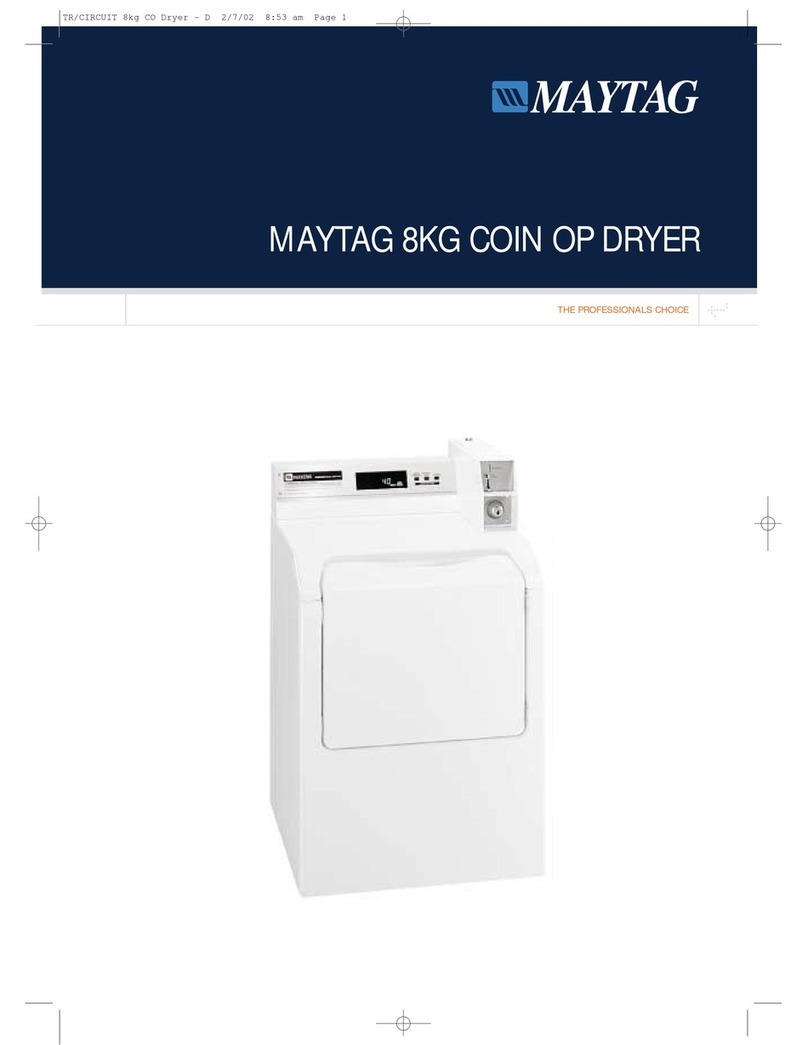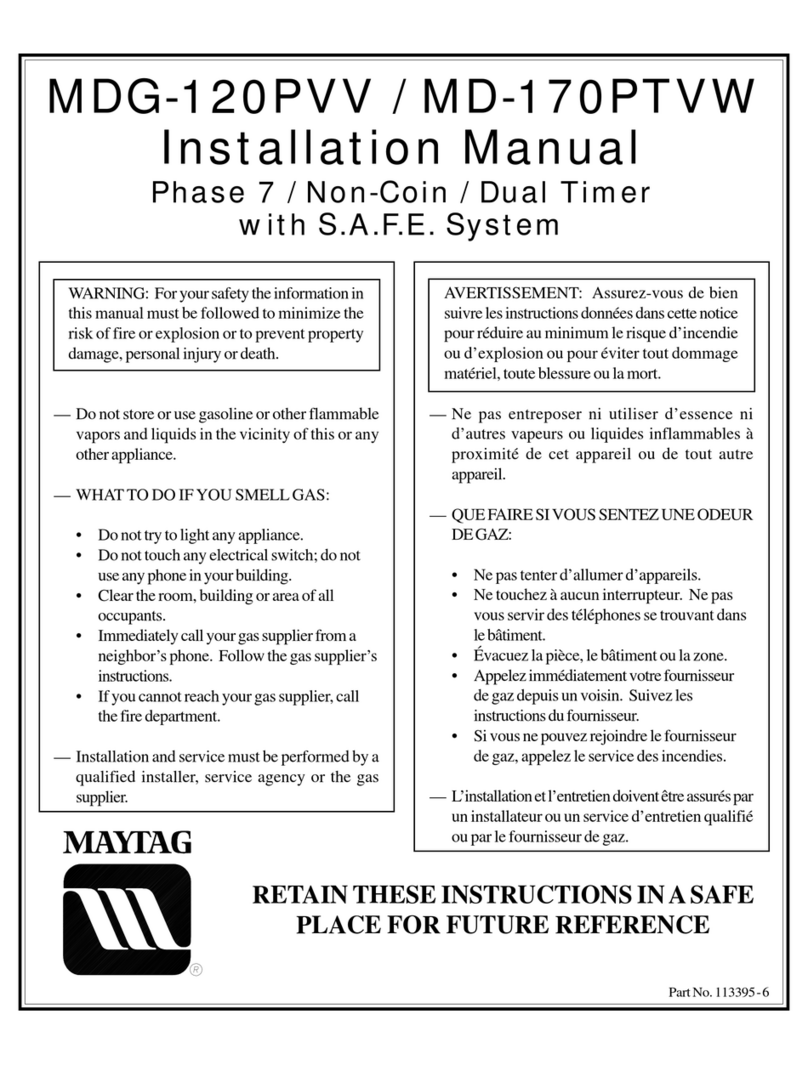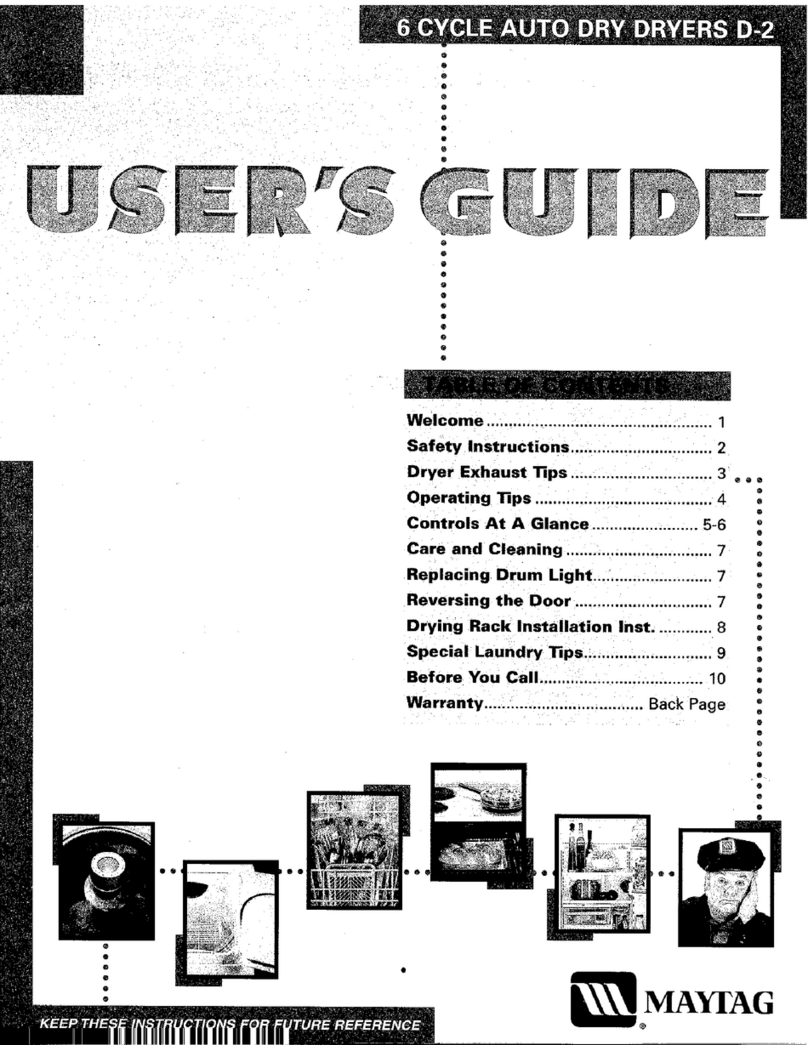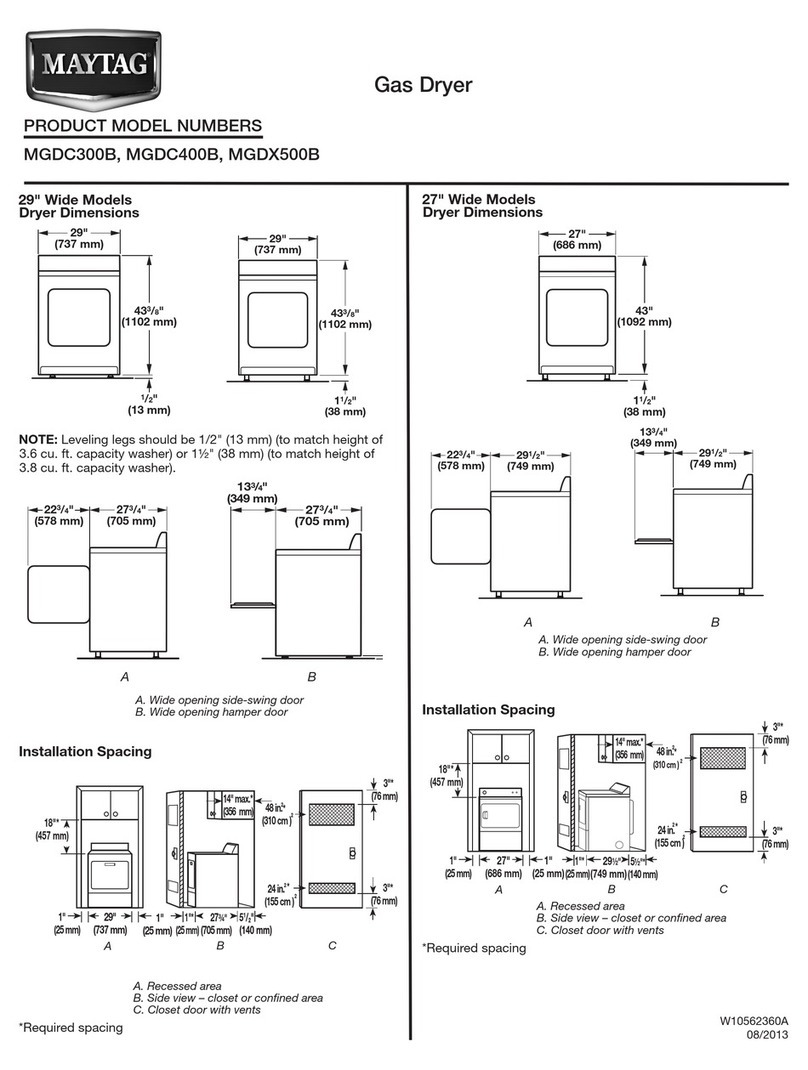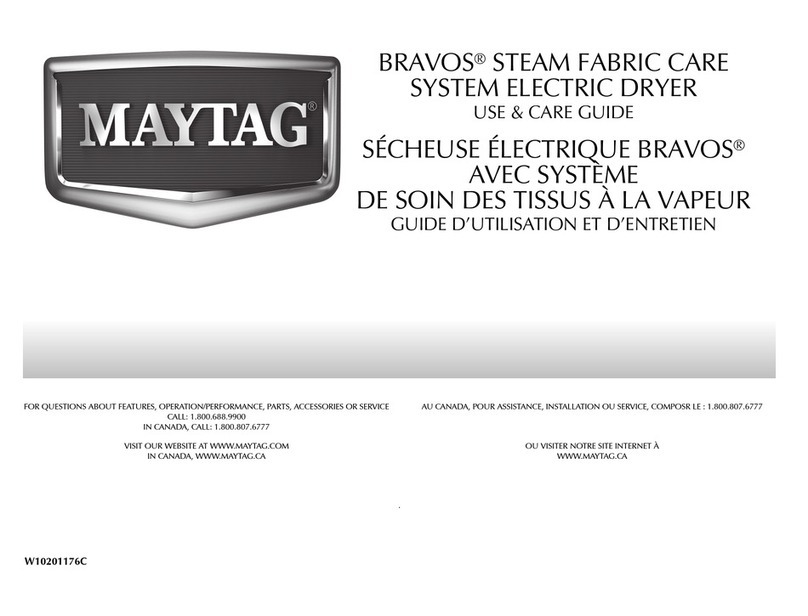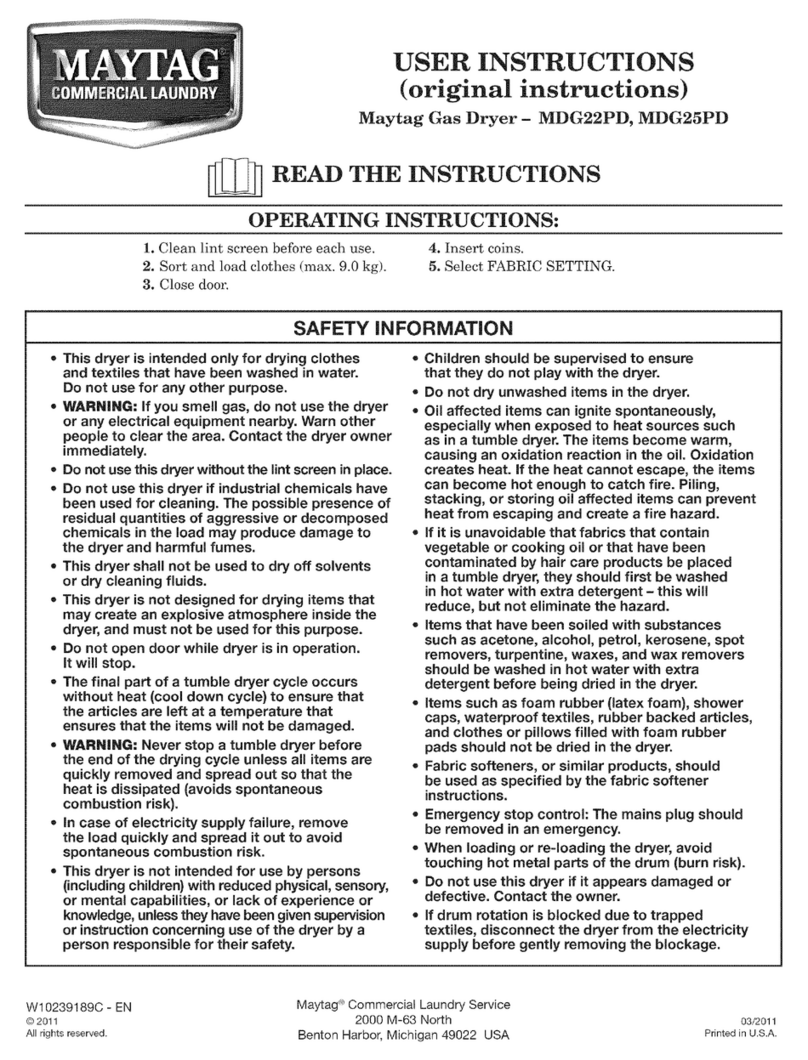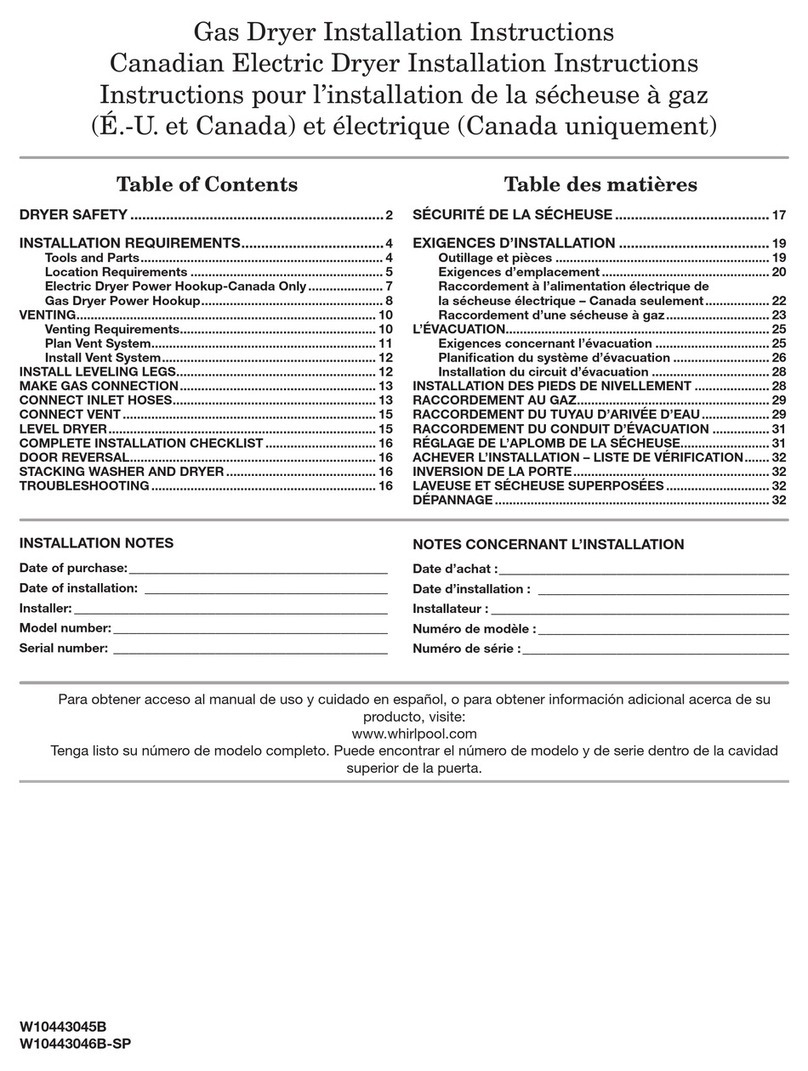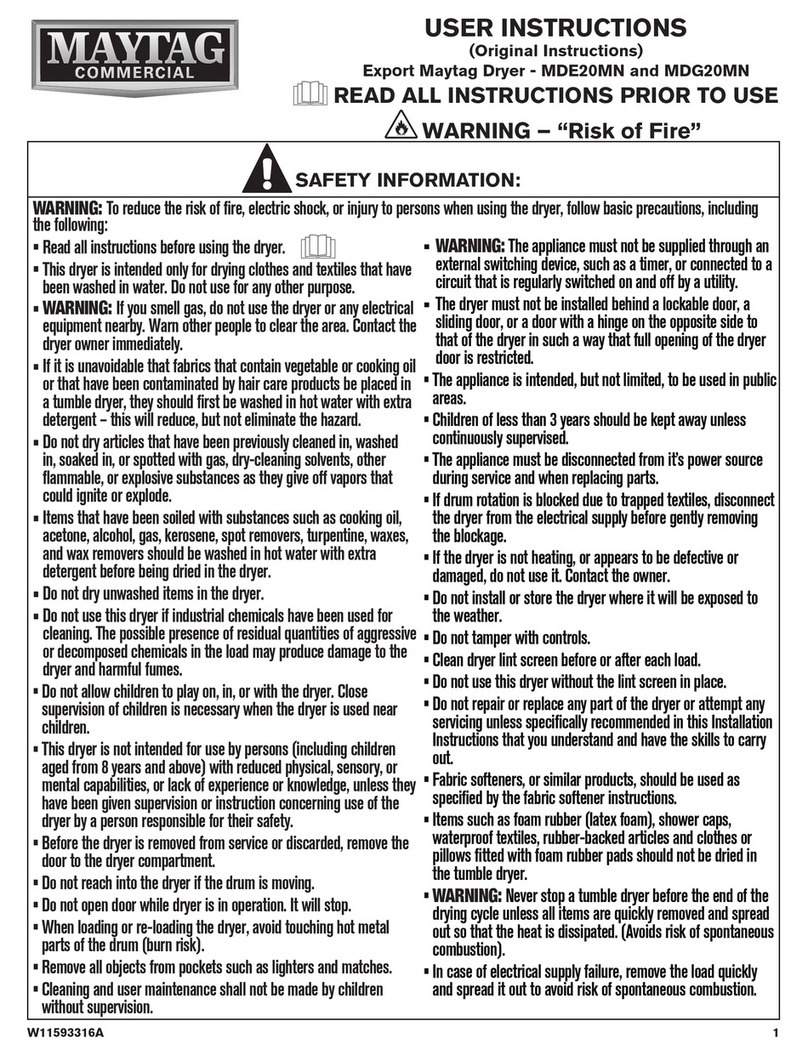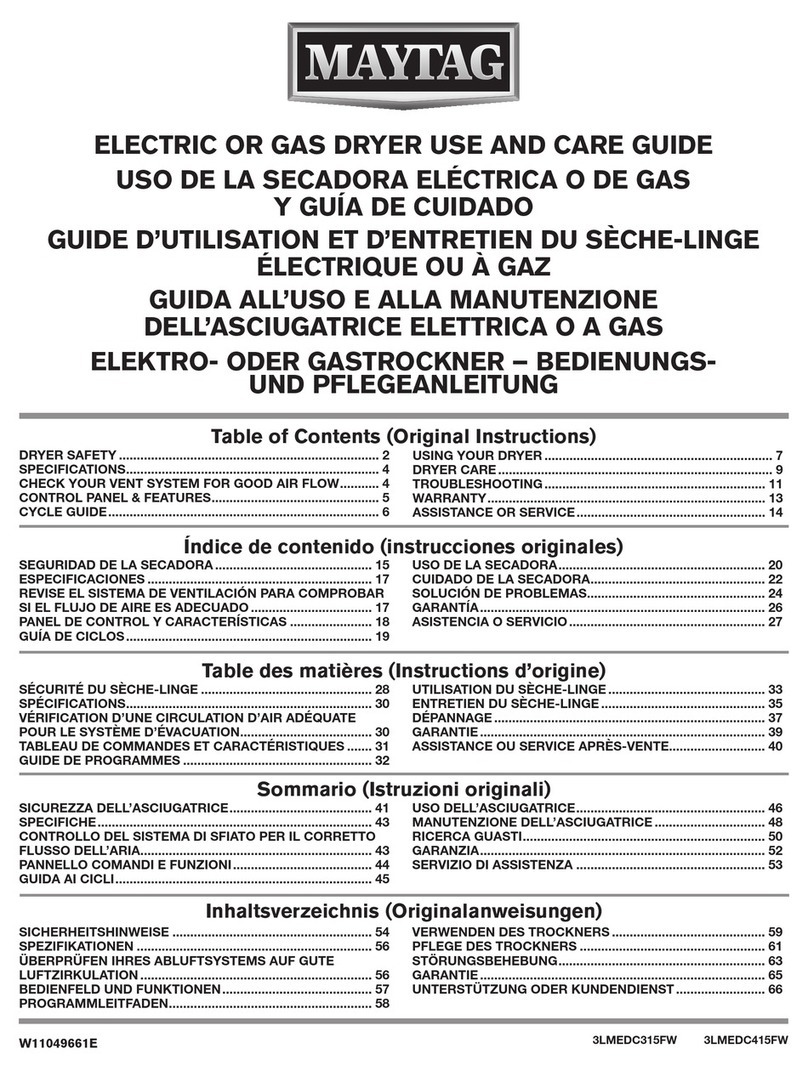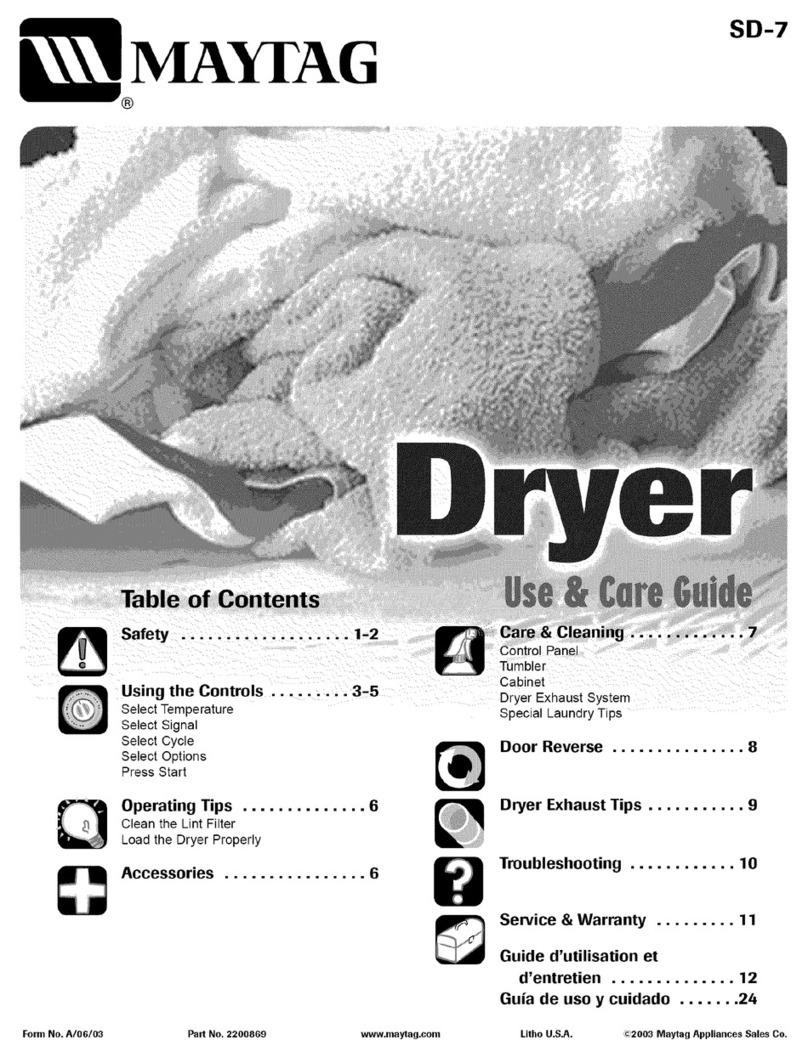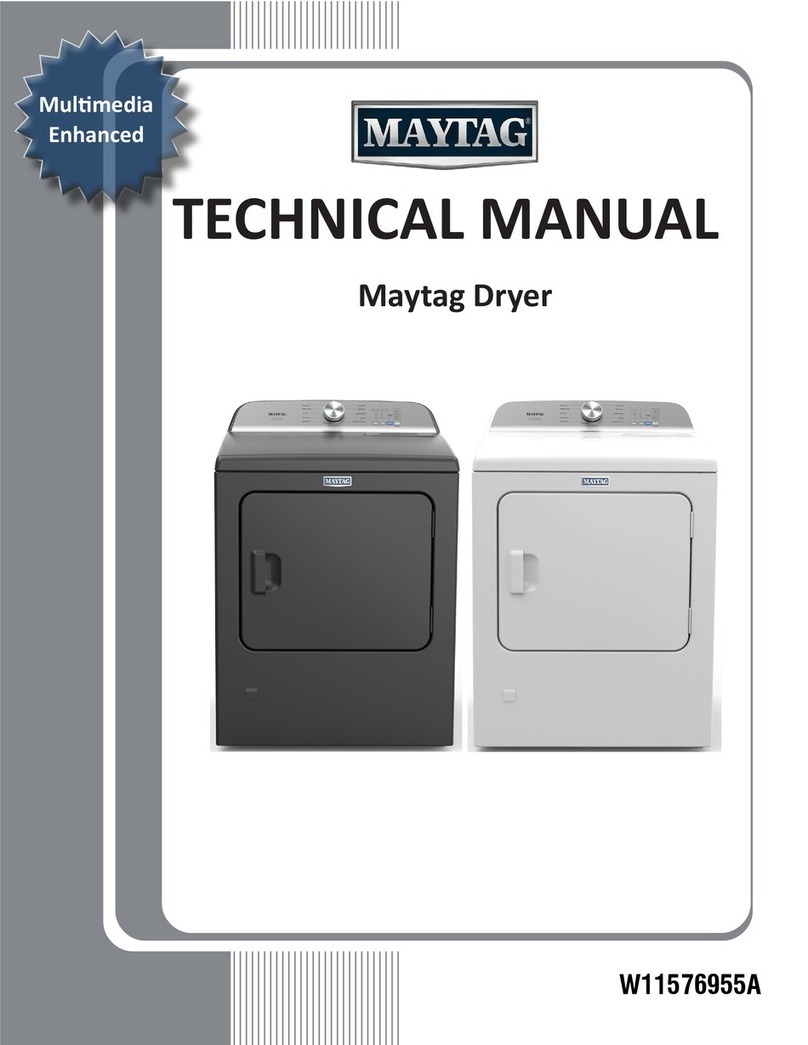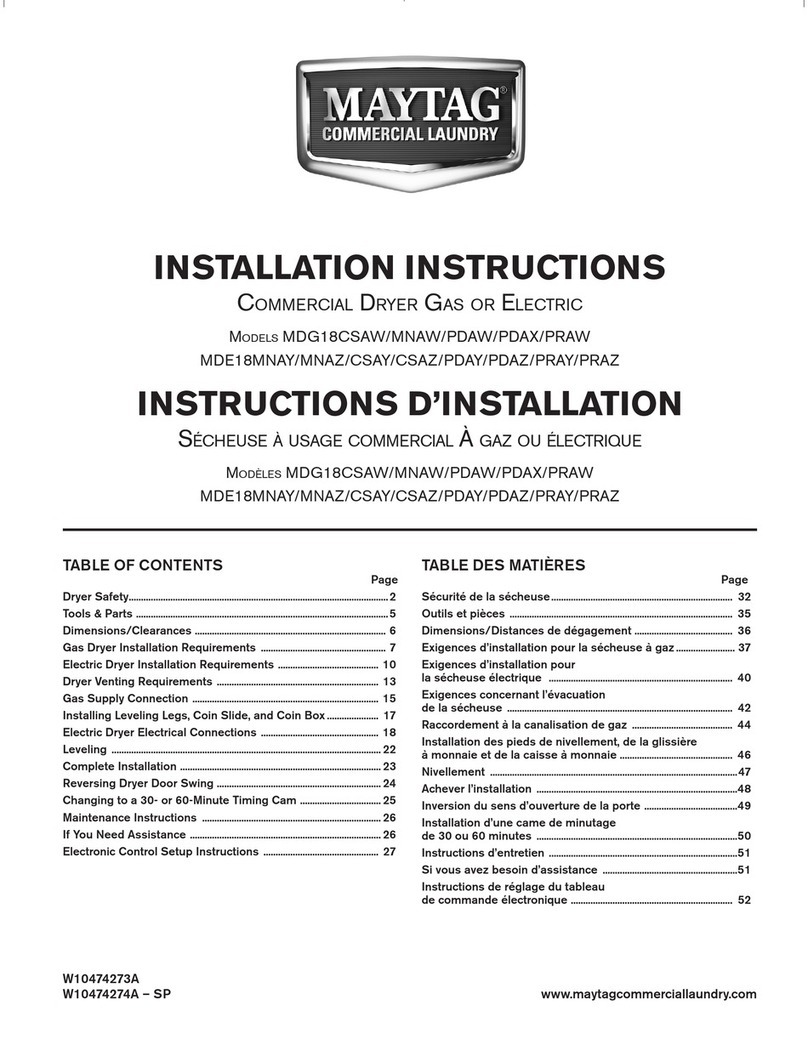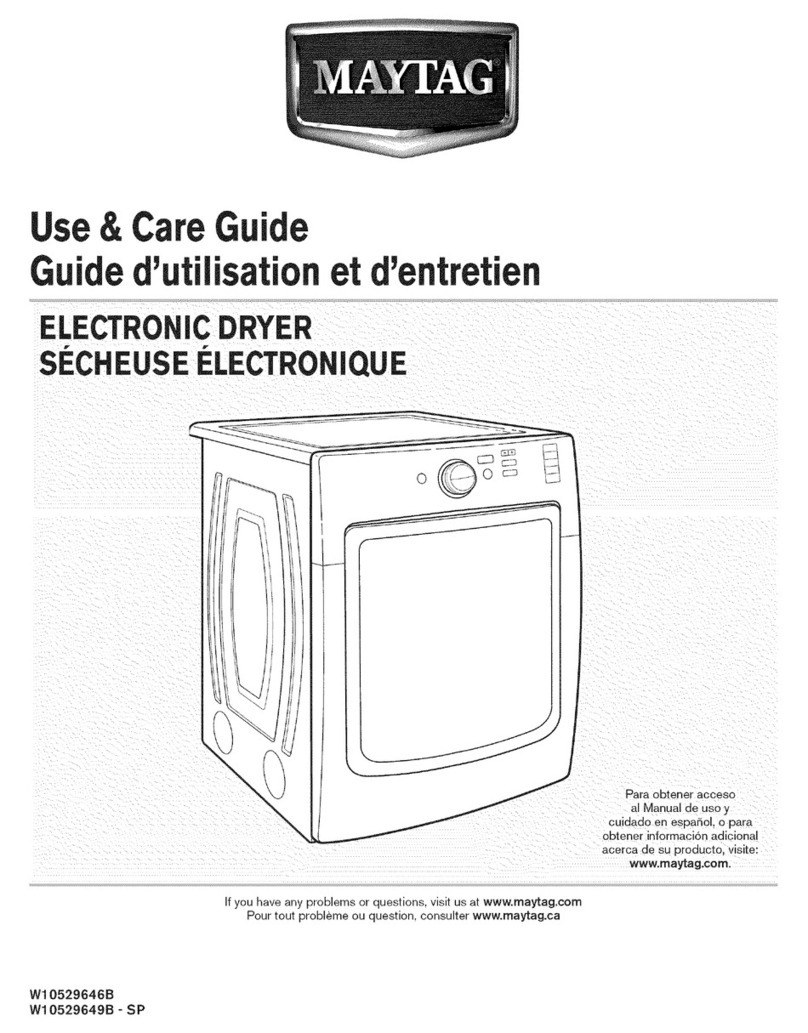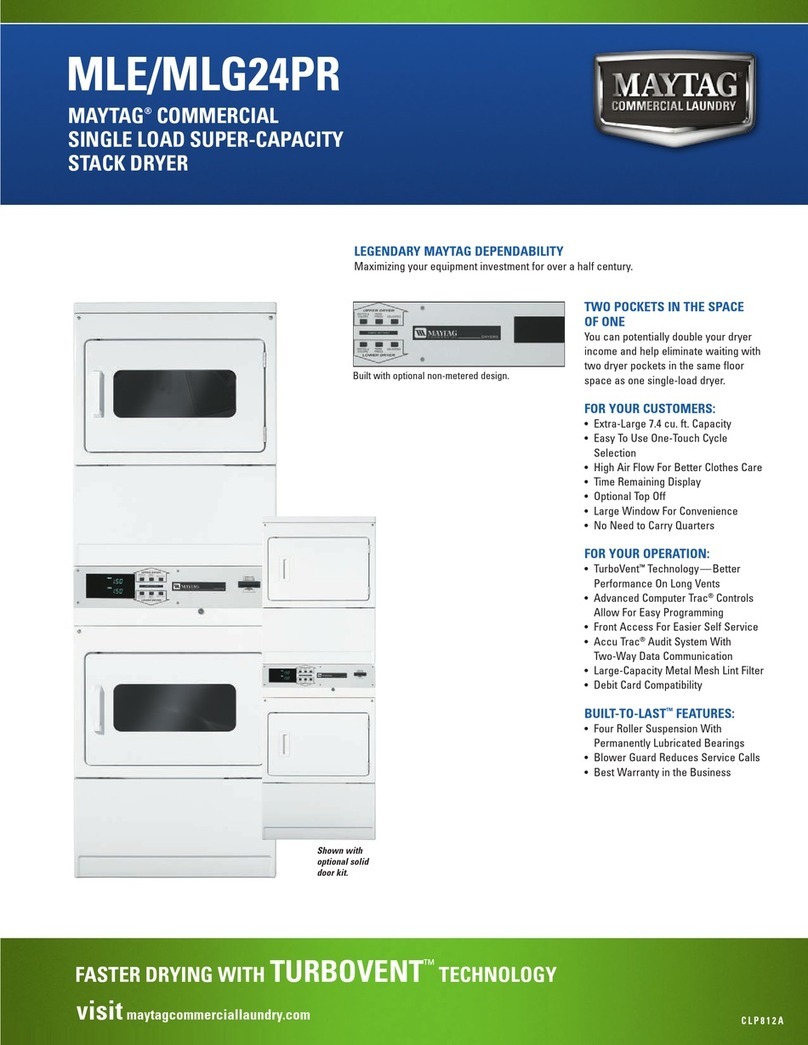
4
DRYER SAFETY
IMPORTANT SAFETY INSTRUCTIONS
WARNING: To reduce the risk of re, electric shock, or injury to persons when using the dryer,
follow basic precautions, including the following:
SAVE THESE INSTRUCTIONS
nRead all instructions before using
the dryer.
nThis dryer is intended only for drying
clothes and textiles that have been
washed in water. Do not use for any other
purpose.
nWARNING: If you smell gas, do not use
the dryer or any electrical equipment
nearby. Warn other people to clear the
area. Contact the dryer owner immediately.
nOil-affected items can ignite
spontaneously, especially when exposed
to heat sources such as a tumble dryer.
The items become warm, causing an
oxidation reaction in the oil. Oxidation
creates heat. If the heat cannot escape,
the items can become hot enough to catch
re. Piling, stacking or storing oil-affected
items can prevent heat from escaping and
so creates a re hazard.
nTo reduce the risk of re due to
contaminated loads, the nal part of a
tumble dryer cycle occurs without heat
4
IMPORTANT SAFETY INSTRUCTIONS
precautions, including the following:
WARNING:
Read all instructions before using the dryer.
Keep a minimum clearance of 100 mm (4 in.) between the
rear of the dryer and any wall.
The operation of this appliance may affect the operation of
other types of appliances which take their air supply for safe
combustion from the same room. There has to be adequate
ventilation to replace exhausted air and thus avoid the
back-ow of gases into the room from appliances burning
other fuels, including open res, when operating the tumble
dryer. If in doubt, consult the appliance manufacturers.
Do not obstruct the air supply to the dryer (see Installation
Instructions for minimum clearances).
Do not place items exposed to cooking oils in your dryer.
Oil-affected items can ignite spontaneously, especially when
exposed to heat sources such as in a tumble dryer. The
items become warm causing an oxidation reaction in the oil.
Oxidation creates heat. If the heat cannot escape, the items
can become hot enough to catch re. Piling, stacking or
storing oil-affected items can prevent heat from escaping
and so create a re hazard.
If it is unavoidable to dry in the dryer items that have been
soiled with substances such as cooking oil, acetone, alcohol,
petrol, kerosene, spot removers, turpentine, waxes and wax
removers, or that have been contaminated by hair care
products, should be washed in hot water with an extra
amount of detergent before being dried in the dryer. These
items may give off vapours that could ignite or explode. Such
washing will reduce, but not eliminate, the hazard.
This appliance is not intended for use by persons (including
children) with reduced physical, sensory or mental
capabilities, or lack of experience and knowledge, unless
they have been given supervision or instructions concerning
use of the appliance by persons responsible for their safety.
Children should be supervised to ensure that they do not
play with the appliance.
The dryer should not be used if industrial chemicals have
been used for cleaning.
Before the dryer is removed from service or discarded,
remove the doors to the drying compartment.
Do not reach into the dryer if the drum is moving. A door
switch is tted for your safety.
Do not install or store the dryer where it will be exposed
to the weather.
Do not tamper with controls.
Do not continue to use this appliance if it appears to be
faulty.
Do not repair or replace any part of the dryer or attempt
any maintenance unless specically recommended in this
Use and Care Guide. Repairs and servicing should only
be carried out by competent service personnel.
Do not use fabric softeners or products to eliminate static
unless recommended by the manufacturer of the fabric
softener or product. Follow their instructions.
Clean dryer lint screen before or after each load. Do not
operate dryer without lint screen in place.
Keep area around the exhaust and inlet openings and
adjacent surrounding areas free from the accumulation of
lint, dust, and dirt.
The interior of the dryer and exhaust vent should be
cleaned periodically by qualied service personnel.
See Installation Instructions for earthing instructions.
Do not dry unwashed items in this dryer.
Items such as foam rubber (latex foam), shower caps,
waterproof textiles, rubber backed articles and clothes or
pillows tted with foam rubber pads must only be dried
on a clothesline.
SAVE THESE INSTRUCTIONS
WARNING: Never stop a tumble dryer cycle before the
end of the drying cycle unless all items are quickly removed
and spread out so that the heat is dissipated.
To reduce the risk of re, electric shock, or injury to persons when using the dryer, follow basic
The nal part of a tumble dryer cycle occurs without heat
(cool down cycle) to ensure that the items are left at a
temperature that ensures the items will not be damaged.
If the supply cord is damaged, it must be replaced by the
manufacturer or its service agent or a similarly qualied
person in order to avoid a hazard.
WARNING:
FIRE OR EXPLOSION HAZARD
Failure to follow safety warnings exactly could result in serious injury, death or property
damage.
–
–
Do not store or use gasoline or other flammable vapors and liquids in the vicinity of this
or any other appliance.
WHAT TO DO IF YOU SMELL GAS:
–Installation and service must be performed by a qualified installer, service agency, or
the gas supplier.
•Do not try to light any appliance.
•Do not touch any electrical switch; do not use any phone in your building.
•Clear the room, building, or area of all occupants.
•Immediately call your gas supplier from a neighbor's phone. Follow the gas supplier's
instructions.
•If you cannot reach your gas supplier, call the fire department.
(cool down period). Avoid stopping
a tumble dryer before the end of the
drying cycle unless all items are quickly
removed and spread out so that the heat is
dissipated.
nIf it is unavoidable that fabrics that
contain vegetable or cooking oil or that
have been contaminated by hair care
products be placed in a tumble dryer, they
should rst be washed in hot water with
extra detergent – this will reduce, but not
eliminate the hazard.
nDo not dry articles that have been
previously cleaned in, washed in, soaked
in, or spotted with petrol, dry-cleaning
solvents, other ammable, or explosive
substances as they give off vapors that
could ignite or explode.
nItems that have been soiled with
substances such as acetone, alcohol,
petrol, kerosene, spot removers,
turpentine, waxes, and wax removers
should be washed in hot water with extra
detergent before being dried in the dryer.
